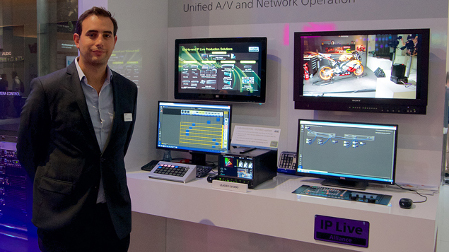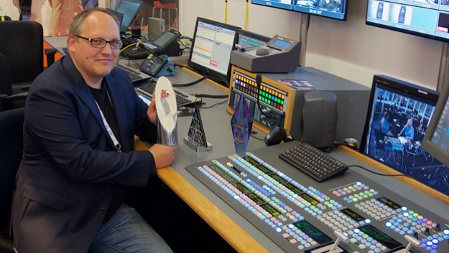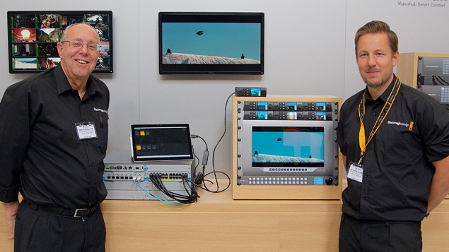The Internet Protocol: Making the Connection for Live Production
LONDON—According to many companies at this past year's IBC show in Amsterdam, 2016 was the year of IP production. Those of you who have been using IP connections (or Ethernet networks) for editing and post-production for at least a decade might wonder what the fuss is about, but moving a few files around between computers is not the same as handling a live sporting event over a network.
Live production using IP is difficult. So, why do it?
The problem is that moving to Ultra HD using current broadcast infrastructure isn’t easy either. 3G-SDI cables can only handle HD, so you either need four of them for UHD (quad-link SDI), or use some sort of compression, or you move to IP, which has some additional advantages.
“Playout moved to IP about 10 years ago,” but only now is IP really becoming usable for live production, and “the take up is really quite strong,” said Chuck Meyer, CTO of Grass Valley.

Nicolas Moreau
“It isn’t so much that the customer wants IP for the sake of IP. They want what it enables,” particularly in terms of quickly taking a piece of content and making money out of it. Another big attraction is doing live remote productions, “using distributed resources.” However, you need to build “a different type of video factory,” he said.
IP is also not necessarily the cheapest option, although Meyer believes it will be justified by total cost of ownership (even if some of the equipment will cost more), “because it is so much more flexible and easier to allocate capabilities and capacity elsewhere. You really don’t need the stack of kit you used to. The native cost may be more, but the optimized cost may be less. Also, the fact that so many processes can be done simultaneously means greater efficiency.”
Get the TV Tech Newsletter
The professional video industry's #1 source for news, trends and product and tech information. Sign up below.
“If you want the same workflows as you can do in SDI, moving to IP is pointless,” said Nicolas Moreau, Sony’s product marketing manager, IP live production & workflows. “IP gives the opportunity to do so much more with the same equipment, or to decentralize equipment,” whether for remote production or to make it easier to share resources or people between shows. “If you want one of the world’s top vision mixers to work on an event in Paris, they could stay in London and do it from there.”
A crucial element in moving to IP is being able to drag your existing investment in SDI along with you, which is why Sony’s IP starter kit includes two SDI-to-IP gateways, two IT routers and its Live System Manager software (plus two years of technical support and training—including four days face-to-face). “This is the best smart way to go,” he insisted. “This can become the core of your system, and as more IP-native products come out, you can add them. That’s the beauty of IP. It’s so modular. It means you don’t have to start big.”
Although “most manufacturers are now talking to each other”, users need to conduct interoperability tests, as there are still differences, said Moreau.
SANDBOXED IN
Belgian station VRT has spent the last year working with the EBU and manufacturers to trial live IP production, and used it for children’s programming around Euro 2016 and the Olympics.

Leonid Adamopoulos
There was a demonstration of what it could do at IBC, with a studio on its stand linked to IBC TV’s gallery about 500m away via a single fibre. There was a back-up control room on the stand, but it wasn’t needed. “We’ve proven it works, and it keeps working,” said Leonid Adamopoulos, producer/director, VRT Sandbox.
“One of the big advantages of production over IP is that we can switch much more easily between control rooms, wherever they are,” he added.
“Remote production is the biggest advantage [of IP]. With one control room you can control three or four productions in one day, and they can be 100km away. It’s the future. It will not be stopped.”
LIVE GIGS
Snell Advanced Media is in the process of deploying its first fully IP systems (with BCE Luxembourg due to go live in the New Year), and its latest release products have moved from 10Gbps to supporting dual redundant 40Gbps and 25Gbps network interfaces.
“If you want to get maximum performance go 25Gbps, but the best bang for your buck is 40Gbps, which is four lanes of 10Gbps,” advised Sandy Kellagher, director of software systems, live production and infrastructure, Snell Advanced Media.
He is seeing a lot of interest in using lightweight compression, such as TICO or SMPTE VC-2, which allows UHD acquisition at 10G, “but as 25G and 40G becomes prevalent, the desire to use compression will go away.” 100Gbps systems are already in development, and SAM was using 1U switches with 32x 100G interfaces at IBC. “You can break each out into 4x 25G, which means that each switch is capable of handling 1,000 3G-SDI signals in 1U.”
“Where the complexity lies is not so much in being able to route video, it’s in the whole system, including audio synchronization and timing, and fully redundant control,” he added.
WHAT ABOUT SDI?

Blackmagic team
As UHD requires four 3G-SDI cables to carry the video, anyone wanting SDI, but also wanting only a single cable, could use 12G-SDI. OB companies would like to see it more widely used, but not many manufacturers support it. Blackmagic Design is probably the most prominent, and its senior communications manager, Patrick Hussey, believes that while IP may be where the market is going, SDI is where it’s at now, “and it’s not going to change overnight.”
However, in the long term, he said, IP “will make updating and improving existing systems much easier,” and Blackmagic has started to add IP to its line-up, developing a 10Gbps Ethernet switch, and looking at how it can add IP to its existing products, such as monitors and cameras.
A key product will be the new Teranex Mini IP Video 12G, which will convert any SDI video to IP for transmission over Ethernet, using TICO 4:1 compression, “which is one of the more open standards,” said Hussey. “The encoders are visually lossless, with only about two lines of latency. However, that means you don’t get a clean switch. For clean switches you need one frame delay,” added Hersh Burston, senior product manager, broadcast products. Two of the €433 devices would be useful to connect places that don’t have normal broadcast connections, as they only require a single Ethernet cable.
Adding IP to its products will also allow them to act as a virtual VideoHub, as each has its own IP address, and Blackmagic’s Mac and Windows software can identify all IP devices on a network to have them working together.
PLUG AND PRAY
“SDI made it so easy to get interoperability because it was so highly defined, but this made it difficult to create different workflows. However, IP has lots of variables and changes quickly,” said Meyer, which is why GV and others set up AIMS (the Alliance for IP Media Solutions), “to get everyone driving together to interoperability.”
There is a lot of talk about standards. “But that’s not good enough,” insists Moreau. “The focus should be on the applications they can do.” Working with third-party manufacturers, Sony now has a complete portfolio of products for live IP production, supporting multiple standards through its Networked Media Interface (NMI).
“The goal will be convergence of multiple standards - there won’t be a single standard.” Some standards, such as TR-03 (for Transport of Uncompressed Elementary Stream Media over IP), will be widely supported, but in other areas, such as timing or device discovery, agreement is still a way off. “As new standards emerge, we will adopt them—either through software or firmware updates,” he promised.
Customers can go IP now. “We are making a commitment to deliver interoperability right now, and in future if new standards are adopted,” he added.
OUTSIDE BROADCASTS
As ever with new technology, OBs are the early adopters. “IP system orders are now taking off, with large scale systems on air,” said Marco Lopez, president, Grass Valley, such as Arena Television’s three new triple-expanding IP-based UHD trucks (OBX, OBY and OBZ), which are built around 3Tbps routing networks from Cisco.
“The demands of a 4K/UHD signal are much more easily met with an all-IP network,” said Arena managing director Richard Yeowart. Its new trucks provide “greater flexibility going forward”, are “future-proofed and better able to one day roll out HDR [high dynamic range] and higher frame rates as and when they are required,” he added.
“For us, the biggest advantage was the seamless workflow,” said Jamie Hindhaugh, COO, BT Sport (which OBX is being used for). “We didn’t have to do anything different on our end to reap the benefits of the 4K/UHD and IP technology. This is clearly the right direction for the industry, making it possible for us to provide both HD and 4K/UHD content in parallel for our viewers.” OBX went on air with the world’s first all-IP UHD broadcast covering football in September, while OBY did its first transmission for Sky Sports on a rugby match in October.
An important aspect of the rollout of IP for Lopez is getting the control systems right. “We don’t want the operators to have to know if it’s SDI or IP they are dealing with.” However, some things that are routine with SDI are not so simple in IP, so there is a lot of development still to do.
This story originally appeared on TVT's sister publication, TV Technology Europe.
